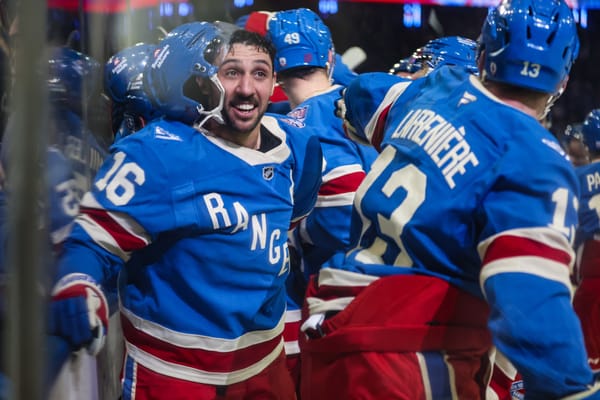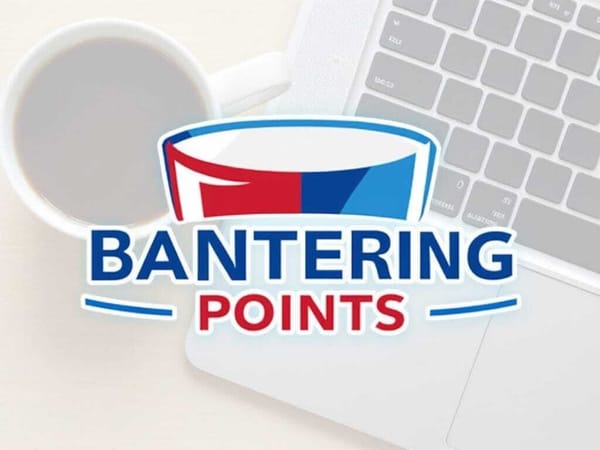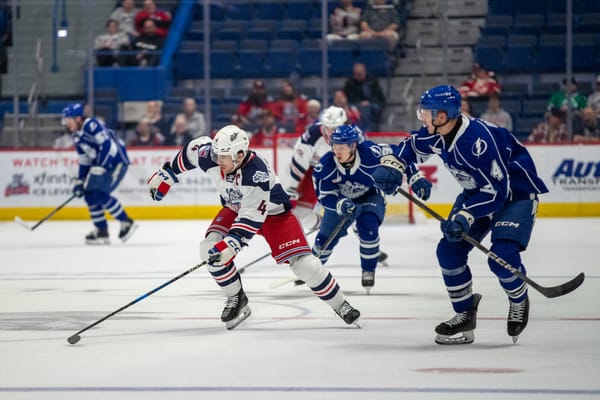Examining How Rangers Could Use Offer Sheets on Anthony Cirelli and Mikhail Sergachev
The Rangers could use an offer sheet, or threaten to use one in order to land one of Tampa’s key RFAs.
When the New York Rangers released “the letter” in February 2018, I am fairly confident the team didn’t picture having two top-three picks in back-to-back seasons. At the time, Glen Sather and Jeff Gorton likely envisioned selling off key pieces who didn’t fit the scope of the rebuild for draft picks and young assets who would complement players selected with the team’s own draft choices.
But sometimes life happens and presents opportunities so great that it makes sense to go in a different direction. For the second year in a row, the Rangers have been given a tremendous gift. Although it would be very defensible for the team to stay the course, now is the time to be bold. In this case, bold can mean weaponizing an offer sheet. By no means is this an earth shattering original idea, but one I’ve been meaning to explore.
The Tampa Bay Lightning have 15 players signed for next season, and just $5,333,334 in space to deal with Anthony Cirelli and Mikhail Sergachev. If you look at the year after, as of now Tampa has $68,791,666 committed to 10 players, so this isn’t just a one year problem. And beyond their top tier RFAs, as of right now Tampa’s entire right side is without a contract for next season, although Erik Cernak is an RFA, and Cal Foote could factor in. The point is, Tampa doesn’t have an easy way out.
Unless someone helps Tampa out by taking a long term contract off their hands — who am I kidding, we all know this is very likely to happen — they likely can’t afford to keep both. But let’s pretend that a team won’t show up, and Tampa is left dangling in the wind at risk of losing one of their players, and that in this hypothetical each player is willing to sign an offer sheet.
Cirelli is 23, Sergachev is 22, and neither have arbitration rights. With both making under $900,000, an offer sheet anywhere above $6 million would be enticing for them to sign, but would likely need to be even higher to create a situation that locks up Tampa a bit.
Per Cap Friendly, any offer sheet with an AAV between $4,227,438 and $6,341,152 would require surrendering a first round pick, and a third round pick. Anything between $6,341,153 and $8,454,871 would involve surrendering a first, second, and third round pick. This may sound steep, but soon the Rangers will soon be in a position where they will need to surround their roster with more NHL talent, and they can afford to sacrifice some future picks given how they have built their prospect pool, and what they could add in October. As it stands, they may have not enough roster spots for their prospects, let alone anything they add going forward. This doesn’t mean the Rangers should be reckless or avoid opportunities to draft more young talent, but if they can add young NHL ready talent, it would be worth their while.
While offer sheets rarely happen in the NHL, perhaps there’s more of an opening now after Montreal sent one to Carolina for Sebastian Aho. In the case of the Rangers, if done properly, they could all but guarantee landing one of the two players. With that said, what would the process look like?
Step 1 would see Jeff Gorton give general manager Julien BriseBois a ring and attempt to work out a trade package that’s fair for both sides, although it could slant a bit in New York’s favor given Tampa’s financial predicament. While BriseBois likely would say, “no, we want to keep both players, and will find a way to do so,” Gorton doesn’t have to take his no for an answer.
If Step 1 were unsuccessful, Step 2 would involve Gorton sending a “poison pill offer sheet” that is primarily paid in signing bonuses, and has a high enough AAV that if matched would put Tampa in a difficult position to keep both players. For reference, Montreal’s offer sheet to Aho carried an AAV of $8,454,000, $38,620,000 in signing bonuses, and saw $28,120,000 paid in the first three years. Montreal also sent an offer sheet to Brayden Point, but he declined to sign in.
Before going any further, I want to note that it is possible Tampa moves one of their players before the Rangers are able to think about submitting an offer sheet, but for the purposes of this thought experiment, let us assume they do not.
The last time New York had a player sign an an offer sheet was in 1997 for Joe Sakic, and that deal saw $17 million ($15 million signing bonus, $2 million salary) to be paid in year one of the three-year deal. Ultimately the organization was able to match due to the success of Air Force One starring Harrison Ford, and Joe Sakic went on to captain Colorado to another Stanley Cup in 2001.
Fortune favors the bold, and although things appear to be tight, the Rangers are in a position to capitalize where others can’t. The team is somewhat limited on cap space (though there is room for them to cut costs to make a move like this work) in an NHL economy where the cap is flat, but the Rangers have the advantage of having a ton of cash — cash that should have prevented the larger MSG organization from laying off a third of their workforce during a pandemic, but businesses don’t always do the right thing...
While the NHL prides itself on parity, there is one thing that has separated the haves and have nots, and that is signing bonuses. The Rangers and Maple Leafs are two of the league’s richest teams, and both have completed deals in recent years that were heavy on signing bonuses, and low on actual salary. For example, $70,890,000 of John Tavares’ $77 million deal with Toronto is paid in signing bonuses, and $74.5 million of Panarin’s $81.5 million will be paid out the same way.
While Tampa isn’t a poor team, the Lightning generally have reserved big bonuses for established star players. This could have to do with team philosophy, or that owner Jeff Vinik is more careful with his money than say someone like James Dolan.
Steven Stamkos, for example, has $60 million of his $68 million deal in signing bonuses, but Nikita Kucherov, on the other hand, only got $44.5 million in signing bonuses, with the remaining $31.5 million of his $76 million deal coming in actual salary.
They were in a tough position when trying to sign Brayden Point last offseason, and ultimately worked out a three-year deal worth $20.25 million ($6.75M AAV) which paid him $7.75 million total in signing bonuses just before the season started. If the Rangers hypothetically put together a deal that offers more than $10 million in bonuses upfront in a short span, it could present some reason for pause on Tampa’s part.
As a general statement, most NHL franchises don’t give out large amounts of money in one lump sum, and otherwise prefer paying their star players over the length of an NHL season. I would imagine because the pandemic ended the regular season early, and threatens the ability to have fans in the stand to start next season, teams will need to lower their operating cost as new revenue won’t be coming in. Therefore, some will try and limit how much money they dish out up front.
While the idea seems extreme, the precedent for part two of this idea, sending an offer sheet that puts a team to the brink in order to target a second player, goes back to Doug Wilson of the San Jose Sharks.
In 2010, Doug Wilson sent Niklas Hjalmarsson, who was making just $660,000 at the time, a four-year, $14 million offer sheet. After the Blackhawks matched, they were no longer in a financial position to re-sign Antti Niemi, who then signed with the San Jose Sharks.
In this situation, both players are RFAs, but if the Rangers were to submit an offer sheet that paid Cirelli around $6.5 million a season, who is to say that after Tampa matches, they don’t then send a slightly lesser one Sergachev’s way that if matched would put Tampa in a greater bind or vice-versa?
Or, the Rangers could pick the target they really want, and run the risk of giving up draft picks. Maybe something like this?
I am sure there are individuals with a shrewder mastery of the salary cap and CBA who can calculate a better offer, but this is a “high end” offer which would involve some risk for the Rangers.
If you want to make an offer of your own, make sure it follows the new CBA rules in which “front-loaded contracts in any ‘immediately adjacent years’ can’t exceed 25% variance with the first year of that contract, and any year of the contract can’t exceed 60% variance from the highest year of the deal.” The reason here I picked two years is that would time up with Brayden Point being an RFA again.
In any case, an offer sheet would see the Rangers pay more for a player than they are currently worth, with the hope that the deal works out in the long term, and looks even better with a higher salary cap. With said, why Anthony Cirelli?
Cirelli is a budding young talent who would immediately make the Rangers a stronger team defensively, and a player with promising upside from an offensive perspective.
Via Evolving-Hockey, here’s a look at his performance this season vs. that of someone like Ryan Strome.
From a box score perspective, Cirelli finished the season with 16 goals, 28 assists, and 44 points in 68 games, 30 of which came at even strength.
From an underlying numbers perspective, he had a goals for percentage of 68.36, a shot share percentage of 53.33, and an expected goals percentage of 56.25. Of forwards who played at least 500 minutes, Cirelli had the eighth lowest goals against/60 at 1.47, and the eighth highest goal differential per 60 at 1.71. He also was worth 15.7 goals above replacement which was third-best on Tampa Bay.
TL/DR: Cirelli is a strong two-way forward who generates offense, has the puck on his stick often, and doesn’t generally allow significant offense against. It is important to note he’s played just 168 games in his career on a strong Tampa team, but individually he’s had strong results when you exclude his teammates, and he’s a player worth betting on.
If they landed Cirelli, he’d initially be a strong two-way center who helps 5v5, becomes the No. 1 center on the PK, and offers some offensive potential playing behind Zibanejad for the interim.
Long-term it would allow Filip Chytil some more time to develop, maybe even shift to wing, there’s also the chance Cirelli could prove to be a No. 1 center, and that would change how they decide to proceed with Zibanejad once his contract expires, or it could change how the organization views Chytil. I’ll have more on this concept in a future story, so stay tuned for an expansion on my thought process.
Either way, the Rangers can’t afford to go with the same group of centers they did last year, and should do everything in their power to add one of the players they should have forced to be included in the Ryan McDonagh trade.
If they landed Mikhail Sergachev, the Rangers would have another top-four defender for their left side for the foreseeable future. Sergachev has developed as a player over the last few years, and has become better on the defensive end of the puck.
Offensively he posted a line of 10-24-34 in 70 games, with 19 of his points coming at even strength. His underlying numbers 5v5 included a goals for percentage of 58.16, a shot share percentage of 54.14, and an expected goals percentage of 55.28. Sergachev also posted a GAR of 5.5 which ranked third-best on the team behind Victor Hedman, and former Ranger Kevin Shattenkirk.
Sergachev spent this season primarily playing with Kevin Shattenkirk, and in New York could have success playing with Adam Fox, or potentially Jacob Trouba. In due time, maybe he’s someone the team may want to pair with Nils Lundkvist, but the bottom line is that he just turned 22 and is just starting to scratch the surface in terms of potential.
At this point, you are probably wondering how this would work financially. In the offseason teams are allowed to exceed the salary cap by 10%, and while Tampa could do that to keep both young players, they’d effectively be putting themselves in a position to get taken advantage of by other teams in any trades made to become salary cap compliant. The biggest issue is that other teams will be battling a flap cat, and many of the higher cost pieces Tampa could move out have an assortment of partial and full no-trade clauses. This situation would be a cut throat move by Jeff Gorton, but there’s no reason for him to do Julien BriseBois any favors.
I also know there this concept of karma being associated with offer sheets and how issuing one can make your a team a target, but ultimately the Rangers are in the business of trying to build a Stanley Cup contender. There’s always the chance someone tries to get the Rangers back for sending an offer sheet, but that would require the player to sign it which could be unlikely given what New York is building and how their cap situation is going to open up. There’s also going to be an expansion draft in a year, so there’s bound to be teams engaging in similar cut throat deals if they are unable to protect all the players they want, but without the stigma and additional acrimony.
Given where the Rangers are in their rebuild, and what they need (help on the left side and down the middle), it would be a missed opportunity if they didn’t strike while the iron is hot. At the very least, if Gorton went as far to preview the paperwork New York was drawing up to send to one of Tampa Bay’s young stars, one would have to believe BriseBois would try and work out a deal to avoid spiraling even further down into salary cap hell.
Like I said earlier on, don’t get too caught up in the specific financials of how a deal would be structured, but rather the theory and how the Rangers could try and flex their financial muscle. It is possible for the Rangers to go down this road and still take care of their own business, and I will have more on that in a later story.
Overall, the impetus for a move for Cirelli or Sergachev is because in life there are no guarantees, and sometimes it pays to be ready earlier than expected. As the playoffs have continued in Toronto and Edmonton, it is hard not to think about teams like Chicago and Montreal who didn’t expect to make it to the first round, and teams like Pittsburgh and Toronto who didn’t expect to get bounced in round one. Then there’s the Washington Capitals on the verge of being swept by the New York Islanders, a Carolina Hurricanes squad who will only be better next year, and the Columbus Blue Jackets who did a lot this year after losing Matt Duchene, Panarin, and Sergei Bobrovsky. The Rangers have an opportunity to start working on their ascent back to the top of the Metropolitan Division, and if they choose not to improve their team, others in the league will capitalize on their inaction.
The point here is that the Rangers’ roster has a lot of talent, and while by no means is it a Cup contender, it could become more of a contender than pretender if management has the foresight to realize they have already started applying pressure on the gas pedal — and now is as good a time as any to keep pressing. While Tampa Bay will likely do everything it can to find a way, as most teams generally do, going down this road could have a ripple effect which serves as a warning that Jeff Gorton isn’t afraid to use an offer sheet.
New York should be bold, and not afraid to make moves that will have both an immediate and long term impact. The Rangers have a bevy of young talent that won’t be on entry-level deals forever, and trying to maximize that value while they have it is crucial. That, and you want to maximize the value of players like Panarin before age curves catch up to them.
Adding players now will give the Rangers an opportunity to start finalizing a group that gels, and can not only learn a system and game plan that is successful in the regular season, but get to a point where it masters it and is able to go the distance in the playoffs. It will give time to see what players don’t fit the big picture, and who else should be moved out before the team is playing games with higher stakes attached.
Younger players can then replace those who aren’t in the long term picture, but when there are opportunities to be had, the Rangers shouldn’t sit idly because it “isn’t time yet” on the rebuild calendar.
The Rangers certainly have other options, and stay tuned for some follow up pieces which include some long term, and short term options worth considering.
Financial data via Cap Friendly unless otherwise noted. Stats via Evolving-Hockey and HockeyViz.com unless otherwise noted.





